Long-Range Transport of Biomass Burning Aerosols from Southern Africa: A Case Study Using Layered Atlantic Smoke Interactions with Clouds Observations
Abstract
1. Introduction
2. Materials and Methods
Data Sources
3. Results
3.1. Observed Aerosol Size and Chemical Properties
3.2. MERRA2 Reanalysis
3.2.1. Vertical Ozone Distribution
3.2.2. Aerosol Optical Depth
3.3. HYSPLIT Back Trajectory Analysis
3.4. Aerosol Radiative Properties
4. Discussion
Author Contributions
Funding
Data Availability Statement
Conflicts of Interest
References
- Pöhlker, C.; Walter, D.; Paulsen, H.; Könemann, T.; Rodríguez-Caballero, E.; Moran-Zuloaga, D.; Brito, J.; Carbone, S.; Degrendele, C.; Després, V.R.; et al. Land cover and its transformation in the backward trajectory footprint region of the Amazon Tall Tower Observatory. Atmos. Chem. Phys. 2019, 19, 8425–8470. [Google Scholar] [CrossRef]
- Holanda, B.A.; Franco, M.A.; Walter, D.; Artaxo, P.; Carbone, S.; Cheng, Y.; Chowdhury, S.; Ditas, F.; Gysel-Beer, M.; Klimach, T.; et al. African biomass burning affects aerosol cycling over the Amazon. Commun. Earth Environ. 2023, 4, 154. [Google Scholar] [CrossRef]
- Mylonaki, M.; Gini, M.; Georgopoulou, M.; Pilou, M.; Chalvatzaki, E.; Solomos, S.; Diapouli, E.; Giannakaki, E.; Lazaridis, M.; Pandis, S.N.; et al. Wildfire and African dust aerosol oxidative potential, exposure and dose in the human respiratory tract. Sci. Total Environ. 2024, 913, 169683. [Google Scholar] [CrossRef] [PubMed]
- Wells, C.D.; Kasoar, M.; Bellouin, N.; Voulgarakis, A. Local and remote climate impacts of future African aerosol emissions. Atmos. Chem. Phys. 2023, 23, 3575–3593. [Google Scholar] [CrossRef]
- Ridley, H.E.; Asmerom, Y.; Baldini, J.U.; Breitenbach, S.F.; Aquino, V.V.; Prufer, K.M.; Culleton, B.J.; Polyak, V.; Lechleitner, F.A.; Kennett, D.J.; et al. Aerosol forcing of the position of the intertropical convergence zone since AD 1550. Nat. Geosci. 2015, 8, 195–200. [Google Scholar] [CrossRef]
- Kang, S.M.; Xie, S.P.; Deser, C.; Xiang, B. Zonal mean and shift modes of historical climate response to evolving aerosol distribution. Sci. Bull. 2021, 66, 2405–2411. [Google Scholar] [CrossRef]
- Formenti, P.; D’aNna, B.; Flamant, C.; Piketh, S.J.; Schepanski, K.; Waquet, F.; Auriol, F.; Brogniez, G.; Burnet, F.; Chaboureau, J.-P.; et al. The aerosols, radiation and clouds in Southern Africa field campaign in Namibia: Overview, illustrative observations, and way forward. Bull. Am. Meteorol. Soc. 2019, 100, 1277–1298. [Google Scholar] [CrossRef]
- Zuidema, P.; Redemann, J.; Haywood, J.; Wood, R.; Piketh, S.; Hipondoka, M.; Formenti, P. Smoke and clouds above the Southeast Atlantic: Upcoming field campaigns probe absorbing aerosol’s impact on climate. Bull. Am. Meteorol. Soc. 2016, 97, 1131–1135. [Google Scholar] [CrossRef]
- Zuidema, P.; Alvarado, M.; Chiu, C.; de Szoeke, S.; Fairall, C.; Feingold, G.; Zhu, P. Layered Atlantic Smoke Interactions with Clouds LASIC Science Plan: DOE Office of Science Atmospheric Radiation Measurement (ARM) Program. 2015. Available online: http://www.osti.gov/scitech/servlets/purl/1232658 (accessed on 2 May 2024).
- Zhang, J.; Zuidema, P. Sunlight-absorbing aerosol amplifies the seasonal cycle in low-cloud fraction over the southeast Atlantic. Atmos. Chem. Phys. 2021, 21, 11179–11199. [Google Scholar] [CrossRef]
- Mari, C.H.; Cailley, G.; Corre, L.; Saunois, M.; Attié, J.L.; Thouret, V.; Stohl, A. Tracing biomass burning plumes from the Southern Hemisphere during the AMMA 2006 wet season experiment. Atmos. Chem. Phys. 2008, 8, 3951–3961. [Google Scholar] [CrossRef]
- Adebiyi, A.A.; Zuidema, P. The role of the southern African easterly jet in modifying the southeast Atlantic aerosol and cloud environments. Q. J. R. Meteorol. Soc. 2016, 142, 1574–1589. [Google Scholar] [CrossRef]
- Adebiyi, A.A.; Akinsanola, A.A.; Ajoku, O.F. The Misrepresentation of the Southern African Easterly Jet in Models and Its Implications for Aerosol, Clouds, and Precipitation Distributions. J. Clim. 2023, 36, 7785–7809. [Google Scholar] [CrossRef]
- Jenkins, G.S.; de Castro, V.; Cunha, B.; Fontanez, I.; Holzworth, R. The evolution of the wave-one ozone maximum during the 2017 LASIC field campaign at Ascension Island. J. Geophys. Res. Atmos. 2021, 126, e2020JD033972. [Google Scholar] [CrossRef]
- Sedlacek III, A.J.; Lewis, E.R.; Onasch, T.B.; Zuidema, P.; Redemann, J.; Jaffe, D.; Kleinman, L.I. Using the black carbon particle mixing state to characterize the lifecycle of biomass burning aerosols. Environ. Sci. Technol. 2022, 56, 14315–14325. [Google Scholar] [CrossRef]
- Uin, J.; Salwen, C.; Senum, G.; Hayes, C. aosuhsas (01). Oak Ridge National Laboratory (ORNL), Oak Ridge, TN (United States). Atmospheric Radiation Measurement (ARM) Archive; Oak Ridge National Laboratory (ORNL), Oak Ridge, TN (United States). Atmospheric Radiation Measurement (ARM) Data Center, 2014. Available online: https://adc.arm.gov/discovery/#/results/instrument_code::aosuhsas/dataLevel::01 (accessed on 4 November 2024).
- Koontz, A.; Stephen, S.; Rebecca, T. aosco. b1. Oak Ridge National Laboratory (ORNL), Oak Ridge, TN (United States). Atmospheric Radiation Measurement (ARM) Archive; Oak Ridge National Laboratory (ORNL), Oak Ridge, TN (United States). Atmospheric Radiation Measurement (ARM) Data Center, 2016. Available online: https://adc.arm.gov/discovery/#/results/instrument_code::aosco/dataLevel::b1 (accessed on 4 November 2024).
- Koontz, A.; Flynn, C.; Shilling, J. aoppsap1flynn1h. c1. Oak Ridge National Laboratory (ORNL), Oak Ridge, TN (United States). Atmospheric Radiation Measurement (ARM) Archive; Oak Ridge National Laboratory (ORNL), Oak Ridge, TN (United States). Atmospheric Radiation Measurement (ARM) Data Center, 2021. Available online: https://adc.arm.gov/discovery/#/results/instrument_code::aoppsap1flynn1h (accessed on 4 November 2024).
- Randles, C.A.; Da Silva, A.M.; Buchard, V.; Colarco, P.R.; Darmenov, A.; Govindaraju, R.; Smirnov, A.; Holben, B.; Ferrare, R.; Hair, J.; et al. The MERRA-2 aerosol reanalysis, 1980 onward. Part I: System description and data assimilation evaluation. J. Clim. 2017, 30, 6823–6850. [Google Scholar] [CrossRef]
- Stein, A.F.; Draxler, R.R.; Rolph, G.D.; Stunder, B.J.; Cohen, M.D.; Ngan, F. NOAA’s HYSPLIT atmospheric transport and dispersion modeling system. Bull. Am. Meteorol. Soc. 2015, 96, 2059–2077. [Google Scholar] [CrossRef]
- Giles, D.M.; Sinyuk, A.; Sorokin, M.G.; Schafer, J.S.; Smirnov, A.; Slutsker, I.; Eck, T.F.; Holben, B.N.; Lewis, J.R.; Campbell, J.R.; et al. Advancements in the Aerosol Robotic Network (AERONET) Version 3 database–automated near-real-time quality control algorithm with improved cloud screening for Sun photometer aerosol optical depth (AOD) measurements. Atmos. Meas. Tech. 2019, 12, 169–209. [Google Scholar] [CrossRef]
- NASA/LARC/SD/ASDC, Calipso Lidar Level 2 Aerosol Profile, V4-51. Available online: https://doi.org/10.5067/CALIOP/CALIPSO/CAL_LID_L2_05kmAPro-Standard-V4-51 (accessed on 4 November 2024).
- Che, H.; Segal-Rozenhaimer, M.; Zhang, L.; Dang, C.; Zuidema, P.; Dobracki, A.; Sedlacek, A.J., III; Coe, H.; Wu, H.; Taylor, J.; et al. Cloud processing and weeklong ageing affect biomass burning aerosol properties over the south-eastern Atlantic. Commun. Earth Environ. 2022, 3, 182. [Google Scholar] [CrossRef]
- Dezfuli, A.; Ichoku, C.M.; Bosilovich, M.G. Bosilovich. Large-scale climate features control fire emissions and transport in Africa. Geophys. Res. Lett. 2024, 51, e2024GL110179. [Google Scholar] [CrossRef]
- Luo, J.; Zhang, Y.; Zhang, Q.; Wang, F.; Liu, J.; Wang, J. Sensitivity analysis of morphology on radiative properties of soot aerosols. Opt. Express 2018, 26, A420–A432. [Google Scholar] [CrossRef] [PubMed]
- Luo, J.; Zhang, Y.; Zhang, Q. The Ångström exponent and single-scattering albedo of black carbon: Effects of different coating materials. Atmosphere 2020, 11, 1103. [Google Scholar] [CrossRef]
- Eck, T.F.; Holben, B.N.; Reid, J.S.; Dubovik, O.; Smirnov, A.; O’neill, N.T.; Slutsker, I.; Kinne, S. Wavelength dependence of the optical depth of biomass burning, urban, and desert dust aerosols. J. Geophys. Res. Atmos. 1999, 104, 31333–31349. [Google Scholar] [CrossRef]
- Chazette, P.; Flamant, C.; Totems, J.; Gaetani, M.; Smith, G.; Baron, A.; Landsheere, X.; Desboeufs, K.; Doussin, J.F.; Formenti, P. Evidence of the complexity of aerosol transport in the lower troposphere on the Namibian coast during AEROCLO-sA. Atmos. Chem. Phys. 2019, 19, 14979–15005. [Google Scholar] [CrossRef]
- Ajoku, O.; Norris, J.; Miller, A.J. Observed monsoon precipitation suppression caused by anomalous interhemispheric aerosol. Clim. Dyn. 2019, 54, 1077–1091. [Google Scholar] [CrossRef]
- Lee, L.A.; Reddington, C.L.; Carslaw, K.S. On the relationship between aerosol model uncertainty and radiative forcing uncertainty. Proc. Natl. Acad. Sci. USA 2016, 113, 5820–5827. [Google Scholar] [CrossRef]
- Choudhury, G.; Block, K.; Haghighatnasab, M.; Quaas, J.; Goren, T.; Tesche, M. Pristine oceans are a significant source of uncertainty in quantifying global cloud condensation nuclei. Atmos. Chem. Phys. 2025, 25, 3841–3856. [Google Scholar] [CrossRef]
- Hu, A.V.; Kabala, Z.J. Predicting and Reconstructing Aerosol–Cloud–Precipitation Interactions with Physics-Informed Neural Networks. Atmosphere 2023, 14, 1798. [Google Scholar] [CrossRef]

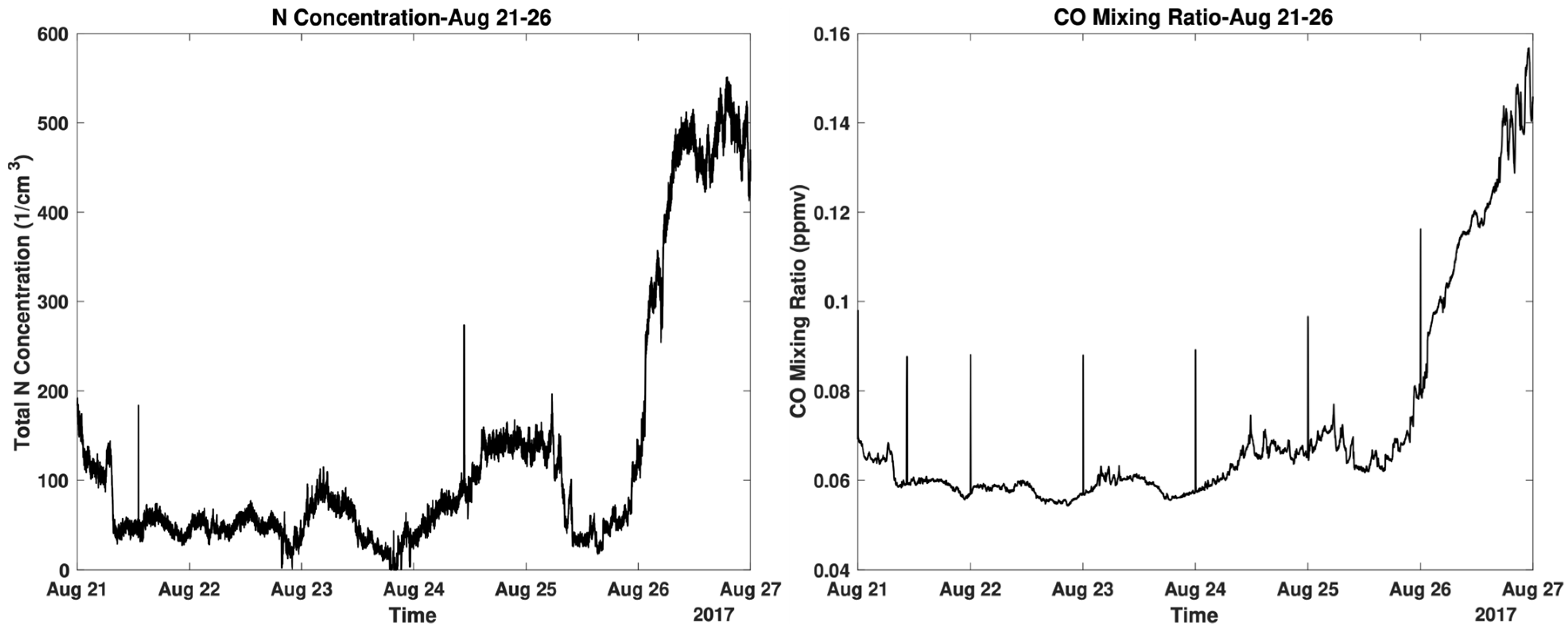
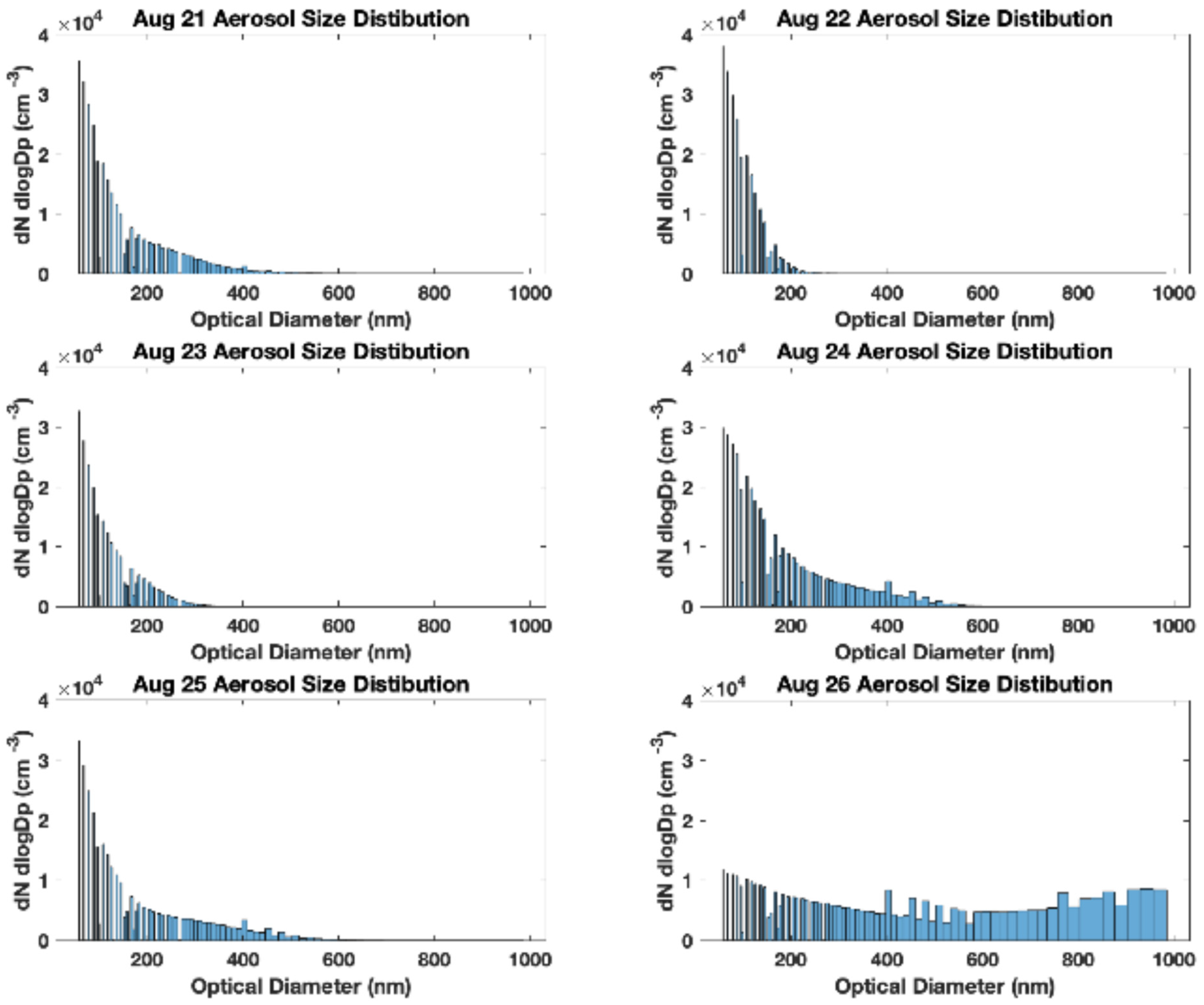
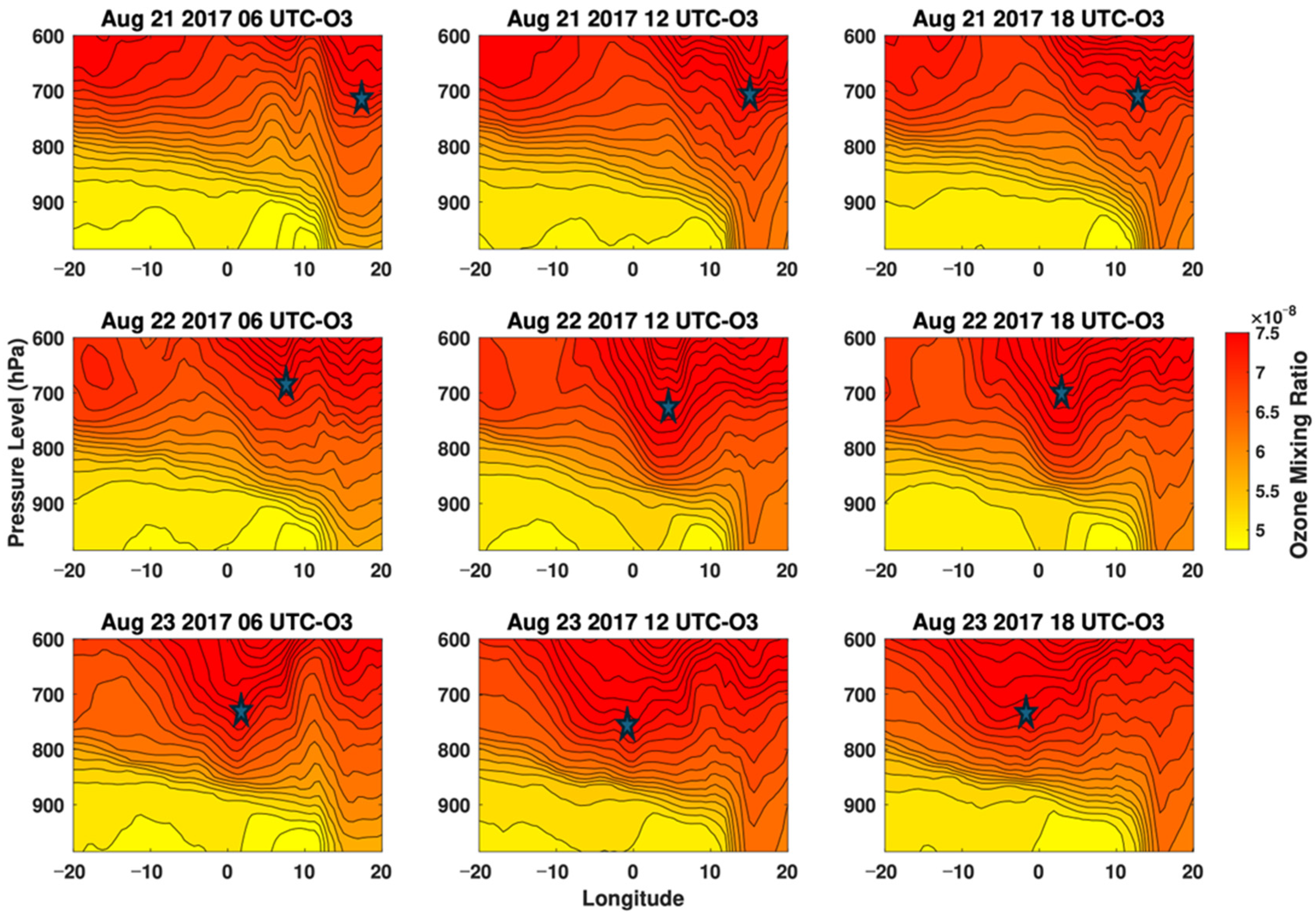
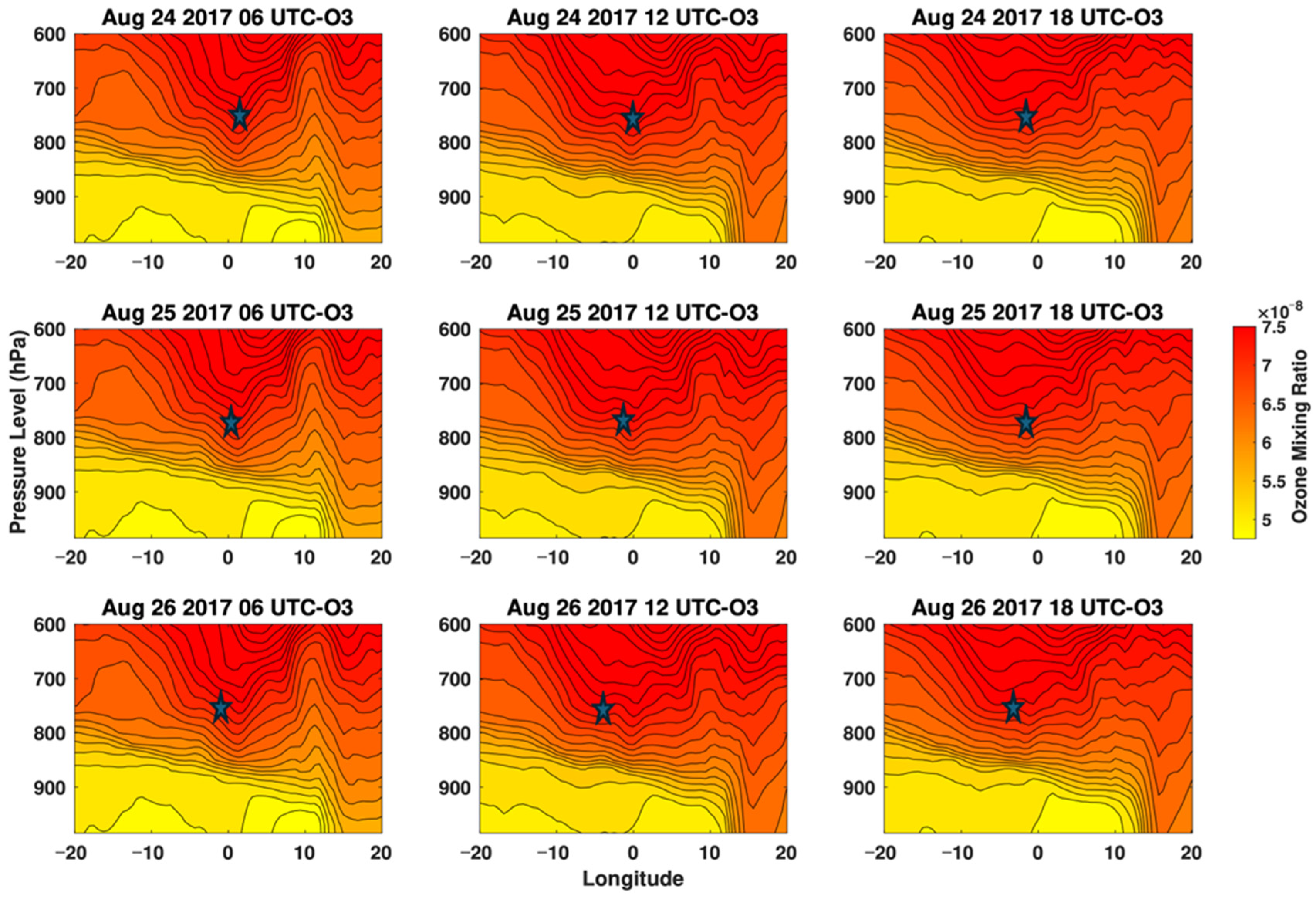


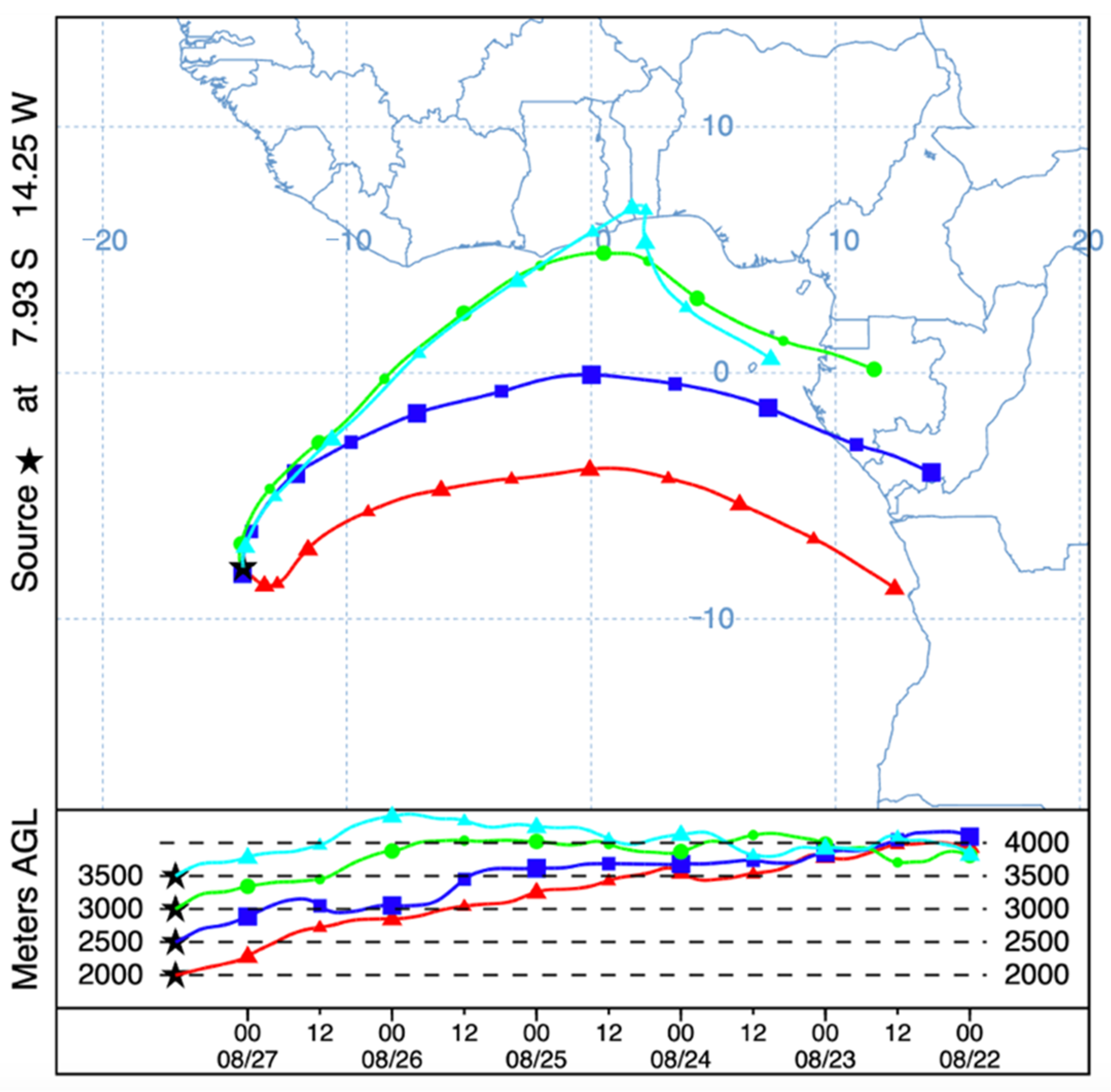
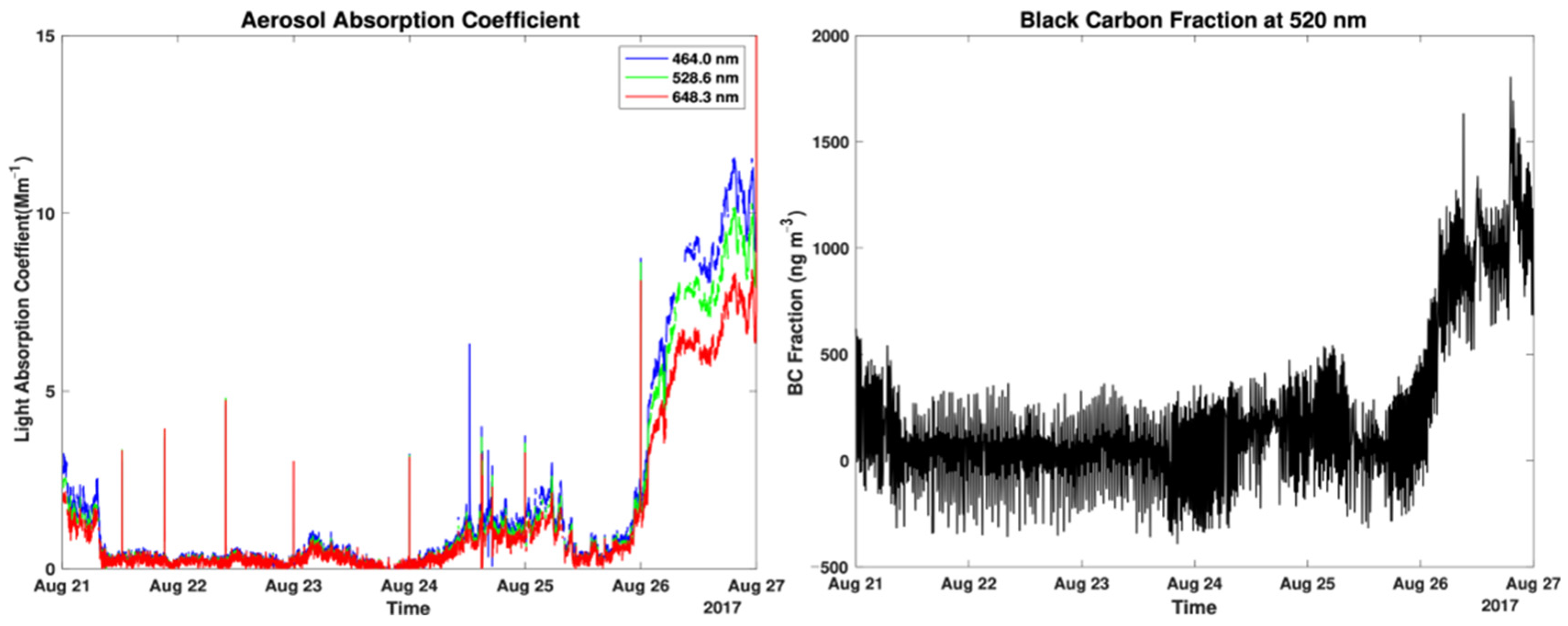
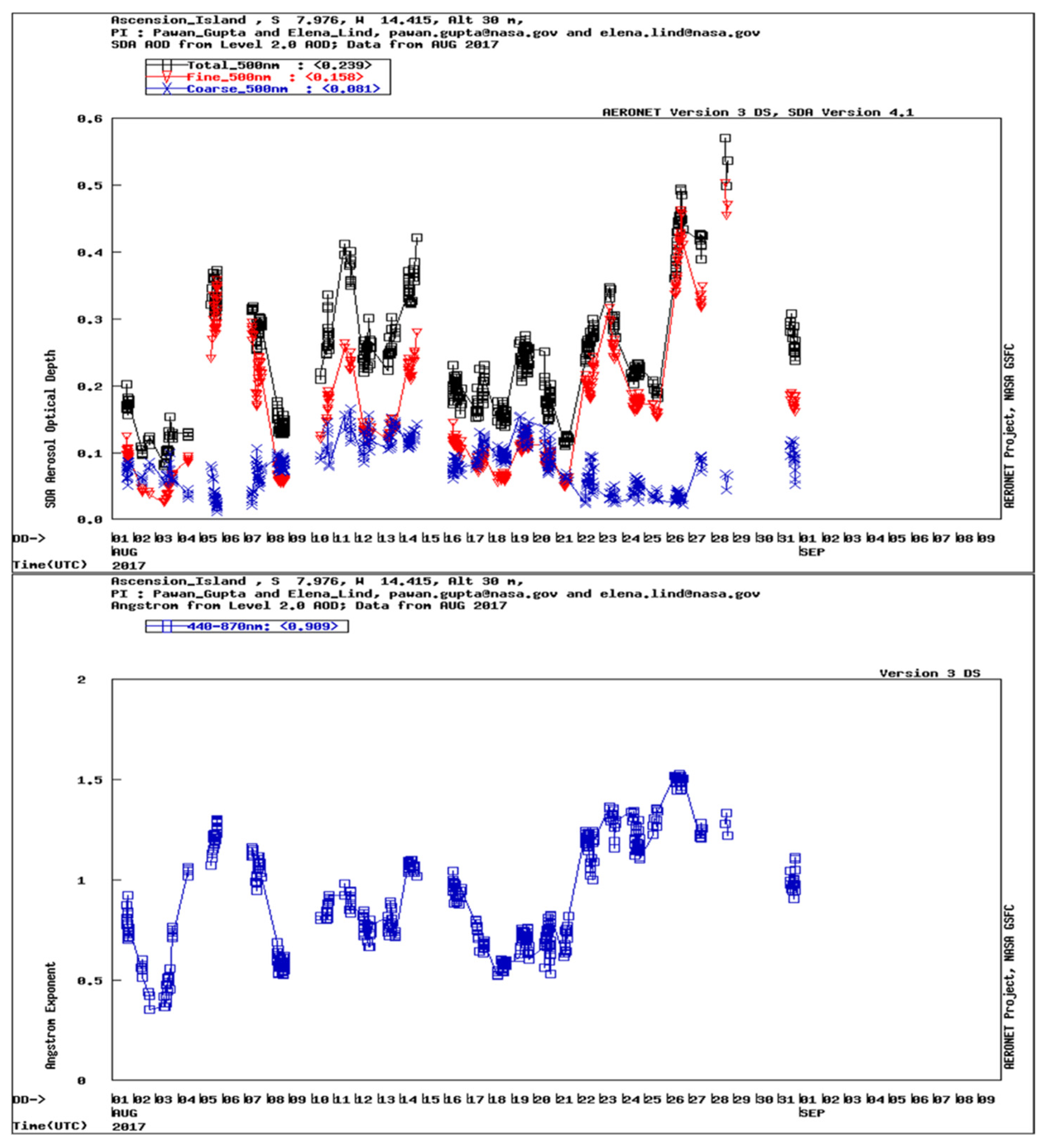

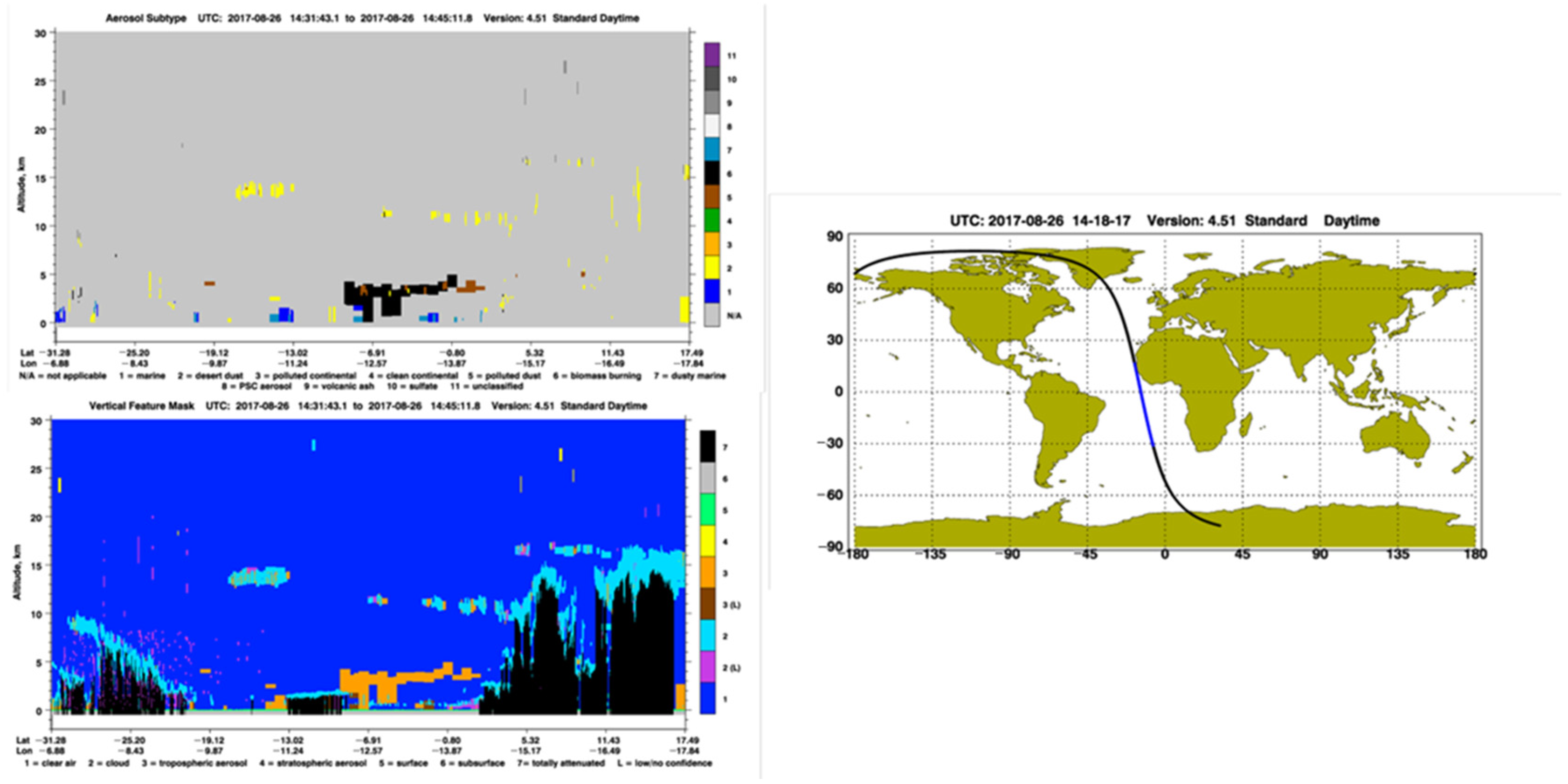
Disclaimer/Publisher’s Note: The statements, opinions and data contained in all publications are solely those of the individual author(s) and contributor(s) and not of MDPI and/or the editor(s). MDPI and/or the editor(s) disclaim responsibility for any injury to people or property resulting from any ideas, methods, instructions or products referred to in the content. |
© 2025 by the authors. Licensee MDPI, Basel, Switzerland. This article is an open access article distributed under the terms and conditions of the Creative Commons Attribution (CC BY) license (https://creativecommons.org/licenses/by/4.0/).
Share and Cite
Ajoku, O.F.; Wilkins, J.L.; Abdulahi, M. Long-Range Transport of Biomass Burning Aerosols from Southern Africa: A Case Study Using Layered Atlantic Smoke Interactions with Clouds Observations. Atmosphere 2025, 16, 997. https://doi.org/10.3390/atmos16090997
Ajoku OF, Wilkins JL, Abdulahi M. Long-Range Transport of Biomass Burning Aerosols from Southern Africa: A Case Study Using Layered Atlantic Smoke Interactions with Clouds Observations. Atmosphere. 2025; 16(9):997. https://doi.org/10.3390/atmos16090997
Chicago/Turabian StyleAjoku, Osinachi F., Joseph L. Wilkins, and Mumin Abdulahi. 2025. "Long-Range Transport of Biomass Burning Aerosols from Southern Africa: A Case Study Using Layered Atlantic Smoke Interactions with Clouds Observations" Atmosphere 16, no. 9: 997. https://doi.org/10.3390/atmos16090997
APA StyleAjoku, O. F., Wilkins, J. L., & Abdulahi, M. (2025). Long-Range Transport of Biomass Burning Aerosols from Southern Africa: A Case Study Using Layered Atlantic Smoke Interactions with Clouds Observations. Atmosphere, 16(9), 997. https://doi.org/10.3390/atmos16090997








